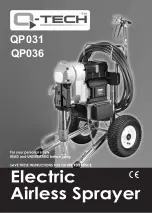
General Spraying and Boom Information
14
When to Spray
Results will be best when the wind speed is low;
temperature is low and relative humidity high. An
ideal time is at sun up when these conditions are
most likely to apply.
Field Patterns
For overall coverage, spray two swaths around
the outer perimeter of the field to establish a wide
headland on which to turn. Make subsequent
passes across the field following the direction of
drilling. Turn the sprayer on and off as the boom
passes over the headland. Spraying into the
established headland will only result in chemical
wastage and overdosing.
Droplet Size
Although more research is needed to define
which is the optimum droplet size collected by
particular targets, certain generalizations can be
made. The trend with herbicides has been to
apply large droplets (250 microns) to reduce the
risk of drift but smaller droplets are often the most
effective as shown by the following table.
Silvan has a range of standard flat fan nozzles
designed for a normal operating pressure of 3.0
bar. If using products containing 2,4-D there are
specific label conditions relating to the size of
spray droplets that must be applied to minimize
drift potential.
In general, the following factors can be varied to
change droplet size.
•
Reducing pressure increases droplet size.
•
Reducing the nozzle fan angle (from 110
0
to
80
0
) increases droplet size.
•
For an equivalent pressure and fan angle a
larger size jet produces larger droplets.
Nozzle Height and Spacing
To achieve a uniform spray pattern without gaps,
the output from adjacent nozzles should overlap
by 50% at the point of contact with the surface
being sprayed.
Nozzles on Silvan booms are spaced at 50 cm
intervals with caps offset 5
0
to the boom axis to
avoid interference between adjacent spray fans.
They can be supplied in 110
0
or 80
0
fan angle.
The correct spray boom height to achieve 50%
overlap is 40 cm for 110
0
nozzles and 60 cm for
80
0
but a variation in the order of 5 to 8 cm can be
accommodated without noticeable effect. The
height referred to is the distance above the target
which may be either the vegetation or the ground
surface depending upon the operation.
Application Rate
The application rate depends on the following:
•
Speed of travel - increasing speed reduces
application rate and vice versa.
•
Operating pressure - increasing pressure
increases application rate and vice versa.
•
Nozzle size - increasing the nozzle size
increases the application rate.
Ground Speed
The ground speed read out on modern tractors
should be sufficiently accurate for spraying but if
in doubt check it by the following method.
Measure and mark a distance of 100 metres. Fill
the sprayer with water and engage the PTO to
simulate normal spraying conditions. Approach
the starting mark at the required spraying speed
and accurately measure the time in seconds to
reach the finishing mark. The ground speed can
be calculated as follows.






































